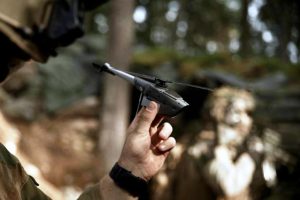
Teledyne FLIR unveils its new Black Hornet 4 Personal Reconnaissance System
Less than one month after the unveiling its Black Recon at DSEI London, Teledyne FLIR unveils a second new product, the Black Hornet 4 Personal Reconnaissance System. While the former is aimed at providing a reconnaissance capability to armoured vehicles, the latter intends providing the soldier on foot with an improved beyond Line-of-Sight recce and surveillance tool, while maintaining it very light and simple

The Black Hornet 3, until today the latest iteration of the original Black Hornet born in Norway over 10 years ago, could provide the soldier with a good video feed generated by two day cameras and by a night channel with a fused thermal sensor. We should not forget that those sensors were packed into a nano-helicopter which weight was less than 33 grams. Although miniaturisation is pushing the boundaries of thermal imagers towards smaller and smaller dimensions, mass and power consumption, it is true that to considerably improve the sensor package a higher payload was needed.

Teledyne FLIR moved therefore to the Black Hornet 4 design. A bigger UAS compared to its predecessor, the weight increase is however equivalent to three 5.56 mm rounds or 1.5 7.62×61 mm round, hence the soldier burden is definitely not increased dramatically. The weight nearly doubles, from 33 to around 70 grams, the rotor diameter stepping up from 123 to 190 mm, while the length goes from 168 to 255 mm. slightly more than a 30 rounds magazine for an AR-15 type rifle, the UAS being still transportable in a pouch to be attached to the combat vest. Data provided by the company indicate a total system weight of 1.3 kg, small enough for a dismounted soldier to carry on a utility belt.
While remaining in the tens of grams payload range, the bigger Black Hornet allows packing in its belly a main electro optical camera with a 12 MP resolution, the company describing it as “excellent in low light”. A set of three electro optic low resolution cameras is used for navigation and collision avoidance, especially when flying inside buildings. When operating at night the Black Hornet 4 can rely on a high sensitivity uncooled thermal imager with a 640×512 matrix, capable to provide a much better image compared to the previous model.

The air vehicle is linked to the ground station via a new a software-defined radio data-link, which ensures an extended range and a heightened resilience.
Increasing dimensions and weight means a better resistance to the wind, and here the improvement is considerable, the Black Hornet 4 being capable to withstand a 25 kts wind, compared to the 15 kts of the Black Hornet 3, and 30 kts guts compared to 20 kts. Not only, is its speed nearly double, over 10 m/s versus 6 m/s. This is not true for endurance, which is increased by 20 per cent, from 25 to 30 minutes, anyway a good result considering the heavier airframe and the improved sensor suite.
According to Teledyne FLIR the Black Hornet 4 establishes the groundwork for Artificial Intelligence, opening the door to spiral enhancements that will further simplify its use and reduce the soldier’s workload.
The Black Hornet 4 is a fully developed product; Teledyne FLIR has already a backlog list and is taking new orders, the Black Hornet 4 being currently in production at the company Hvalstad facility in Norway, first deliveries being planned in 2024.
Photos courtesy Teledyne FLIR
.



